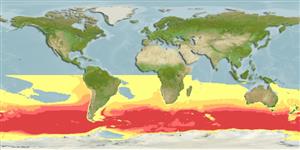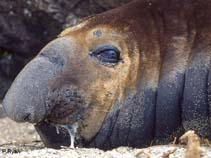Mirounga leonina (Linnaeus, 1758)
Southern elephant seal| Native range | All suitable habitat | Point map | Year 2050 |

|
| This map was computer-generated and has not yet been reviewed. |
| Mirounga leonina AquaMaps Data sources: GBIF OBIS |
Classification / Names Populärnamn | synonymer | CoL | ITIS | WoRMS
Mammalia | Carnivora | Phocidae
Environment: milieu / climate zone / djupintervall / distribution range Ekologi
; djupintervall 0 - 8000 m (Ref. 1394), usually 1000 - 5000 m. Polar; 0°N - 90°S, 180°W - 180°E
Distribution Länder | FAO områden | Ekosystem | Förekomster | Utplanteringar
Indo-Pacific, Atlantic Ocean and the Antarctic: Circumpolar in the Southern Hemisphere, Skeleton coast of Namibia around the Cape to Ilha Bazaruto in Mozambique. Polar, temperate.
Length at first maturity / Size / Weight / Age
Könsmognad: Lm ? range ? - ? cm Max length : 685 cm TL hane/ej könsbestämd; (Ref. 99323); 300 cm TL (female); publicerad maxvikt: 5.0 t (Ref. 99323); publicerad maxvikt: 5.0 t
Prefers sandy and cobble beaches, but will haul out on ice, snow or rocky terrace); they venture inland into tussock grass and other vegetation, and frequently lie in mud wallows. Feeds on 75% cephalopods and 25% fish. Maximum measurements for female species based from Ref. 1394. Reported from 0 m- m (Ref. 1394) but is observed to occur at greater depths based on more recent data (Kaschner, K. pers. comm., 20/10/14). Prefers sandy and cobble beaches, but will haul out on ice, snow or rocky terraces; they venture inland into tussock grass and other vegetation, and frequently lie in mud wallows. Feeds on 75% cephalopods and 25% fish (Ref. 1394).
Life cycle and mating behavior Könsmognad | Reproduktion | Lek | Eggs | Fecundity | Larvae
Main reference
referenser | Koordinator | Medarbetare
Jefferson, T.A., S. Leatherwood and M.A. Webber. 1993. (Ref. 1394)
IUCN Red List Status
(Ref. 130435: Version 2024-2)
Least Concern (LC) ; Date assessed: 12 December 2014
CITES status (Ref. 108899)
Appendix II: International trade monitored
CMS (Ref. 116361)
Not Evaluated
Threat to humans
Human uses
Fiskeri: kommersiell
FAO - fiskeri: species profile | FishSource | Sea Around Us
Verktyg
Ytterligare information
Trophic Ecology
Ekologi
Population dynamics
Tillväxt
Max. ages / sizes
Length-weight rel.
Length-length rel.
Length-frequencies
Mass conversion
Rekrytering
Abundans
Max. ages / sizes
Length-weight rel.
Length-length rel.
Length-frequencies
Mass conversion
Rekrytering
Abundans
Life cycle
Reproduktion
Könsmognad
Fecundity
Lek
Eggs
Egg development
Larvae
Larvdynamik
Könsmognad
Fecundity
Lek
Eggs
Egg development
Larvae
Larvdynamik
Distribution
Human Related
Aquaculture profiles
Stamps, coins, misc.
Stamps, coins, misc.
Outreach
Taxonomy
referenser
Internet-källor
BHL | BOLD Systems | CISTI | DiscoverLife | FAO(fiskeri: species profile; publication : search) | Fishipedia | GenBank (genome, nucleotide) | GloBI | Gomexsi | Google Books | Google Scholar | Google | PubMed | Tree of Life | Wikipedia (Go, sök) | Zoological Record
Estimates based on models
Preferred temperature
(Ref. 115969): 0.1 - 1.6, mean 0.8 (based on 16947 cells).
Price category
(Ref. 80766):
Unknown.



